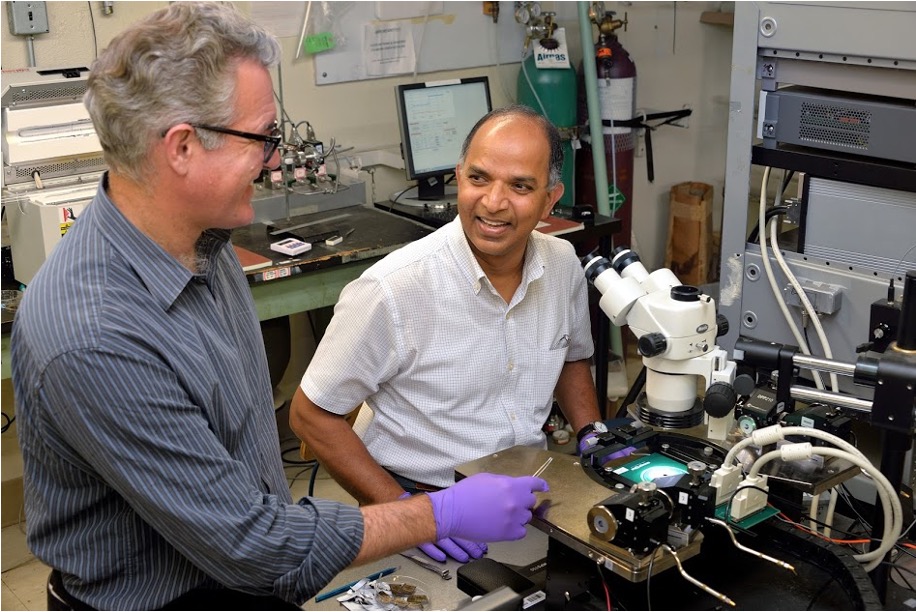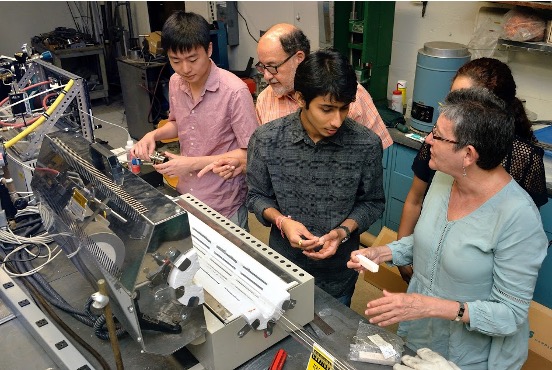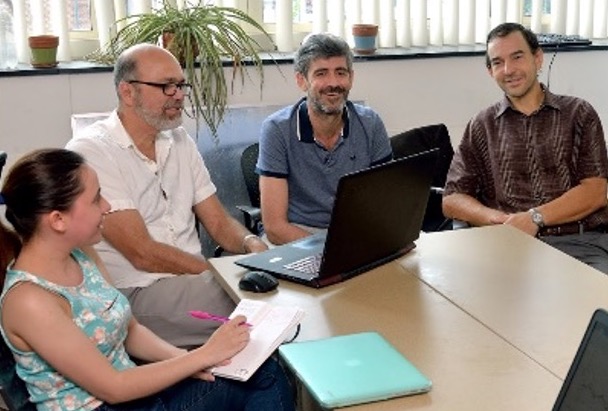


|
The UPR-PENN PREM research is organized as two Interdisciplinary Research Groups (IRGs): "Charge dynamics in transition metal and carbon-based materials" (IRG-1) and "Surface-functionalized nanomaterials for sensing application" (IRG-2). IRG-1 synthesizes, characterizes, and manipulates optoelectronic materials to develop a fundamental understanding of charge transport mechanisms leading to device applications. IRG-2 aims to develop nanomaterials into sensing tools with designed properties and functions for a wide range of applications that include enzyme activity assays, detection of metals and organic pollutants, and monitoring of environmental and biological analyte levels in biological samples. In 2023-2024, PREM was awarded supplemental funds to initiate a collaboration with the NSF Research Traineeship (NRT): "Interdisciplinary Training in Data Driven Soft Materials Research and Science Policy" program at PENN. New training and research collaborations in the area of Autonomous Experimentation were initiated by PREM, MRSEC, and NRT people, and have continued after the award period. The multidisciplinary research teams are built on UPR and PENN faculty researchers’ evolving interests and complementary strengths. See highlights and publications for more information on research activities and results. |
IRG-1. Charge dynamics in transition metal and carbon-based materials: An experimental and theoretical approach centered on device fabrication with improved performanceSenior Investigators: UPR-Humacao - N.J. Pinto (IRG Leader), I. Ramos, N. Zimbovskaya; UPR-Cayey - J. Santana; Drexel University: S. May; PENN - A.T. Johnson, A. M. Rappe, J. Santiago, E.A. Stach, A.G. Yodh |
|
Project 1.1: Graphene and transition metal dichalcogenides Goals: To investigate two dimensional (2-D) electronic materials such as graphene and transition metal dichalcogenides (TMDC) with the goal of fabricating multifunctional devices with superior performance. Senior Collaborators: N.J. Pinto, A.T., Johnson, A. Rappe, E. Stach |
|
Project 1.2: Carbon-based nanomaterials Goals: to understand the relation between fabrication processes, structure, and properties of carbon-based materials for the creation of self-standing and flexible composites with tunable properties for strain sensing. Senior Collaborators: I. Ramos, M., A. Yodh, J. Sotero, D. Lee, J. Santiago |
|
Project 1.3: Thermoelectric transport in mesoscopic and/or nanoscale systems Goals: To explore the effect of coupling between quantum dots and metallic/semicond on heat transport aiming at further improvement of the performance of a double and/or triple quantum dot as a heat rectifier. Senior Collaborators: N. Zimbovskaya, A. Nitzan |
|
Project 1.4: Magnetic Transition Metal-oxide Heterostructures Goals: To understand the role of cation intermixing at the interface of perovskite oxide heterostructures. To use the theory-guided experimental research for the discovery of new perovskite platforms for spintronic transport. Senior Collaborators: J. Santana, A. Rappe, S. May, E. Stach |
IRG-2: Surface-Functionalized Nanomaterials for Sensing ApplicationsSenior Investigators: UPR-Cayey - V. Bansal; (IRG Leader), UPR-Humacao - E. Fasoli, R. Oyola, J. Sotero; UPR-Mayaguez - F. Bezares; University of the Sciences in Philadelphia: P. Moore; PENN - I. Dmochowski, D. Jariwala, D. Lee |
|
Project 2.1: Physical Vapor Deposition of Ag Nanoparticles for Trace Chemical Detection via Surface-Enhanced Raman Scattering (SERS) Goals: To study the morphological and optical properties of Ag thin films grown by magnetron sputtering physical vapor deposition (PVD) onto flat and nanostructured surfaces. Combined with the SERS technique, this will allow for the fabrication of application-designed sensors with improved sensitivity as well as selectivity. Senior Collaborators: F. Bezares, D. Jariwala, E. Fasoli, R. Oyola |
|
Project 2.2: Functionalized gallium nanomaterials for biosensing applications Goals: To identify new gallium-based nanomaterials for analyte sensing and drug delivery. These nanomaterials will be based on nanofibers which provide high loading efficiency and surface to volume area, critical aspects for sensing and delivery applications. Senior Collaborators: R. Oyola, I. Ramos, I. Fasoli, I. Dmochowski, F. Bezares, N.J. Pinto, D. Lee |
|
Project 2.3: Pillararene-modified cellulose matrix for detection and removal of metals and organic molecules Goals: To functionalize an inexpensive, environment-friendly soft material (cellulose) with spacer arms and couple them to newly discovered macrocyclic PAs for trapping and detecting heavy metal and/or organic molecules. Senior Collaborators: E. Fasoli, I. Dmochowski, V. Bansal, J. Sotero, F. Bezares, R. Oyola |
|
Project 2.4: Paper and Emulsion based Biosensing Platforms for Enzyme Activity Assay: Goals: To develop single spot paper-based platforms using microdroplet immobilized reactants for quantitative assay of different enzymes. These paper-based sensors will provide an inexpensive and user-friendly alternative to currently available enzyme activity assays. Senior Collaborators: V. Bansal, E. Fasoli, J. Sotero, I. Dmochowski, D. Lee |
Seed Project: Autonomous ExperimentationSenior Investigators: UPR-Humacao - J. Sotero; I. Ramos; E. Fasoli; R. Oyola, PENN - C. Osuji, P. Shapturenka |
|
Project S1: Optimized 3D-printed devices for separation of carbon spheres |
|
Project S2: Self-driving fluidics lab |
|
Project S3: Real-Time polymer composites fabrication and evaluation |